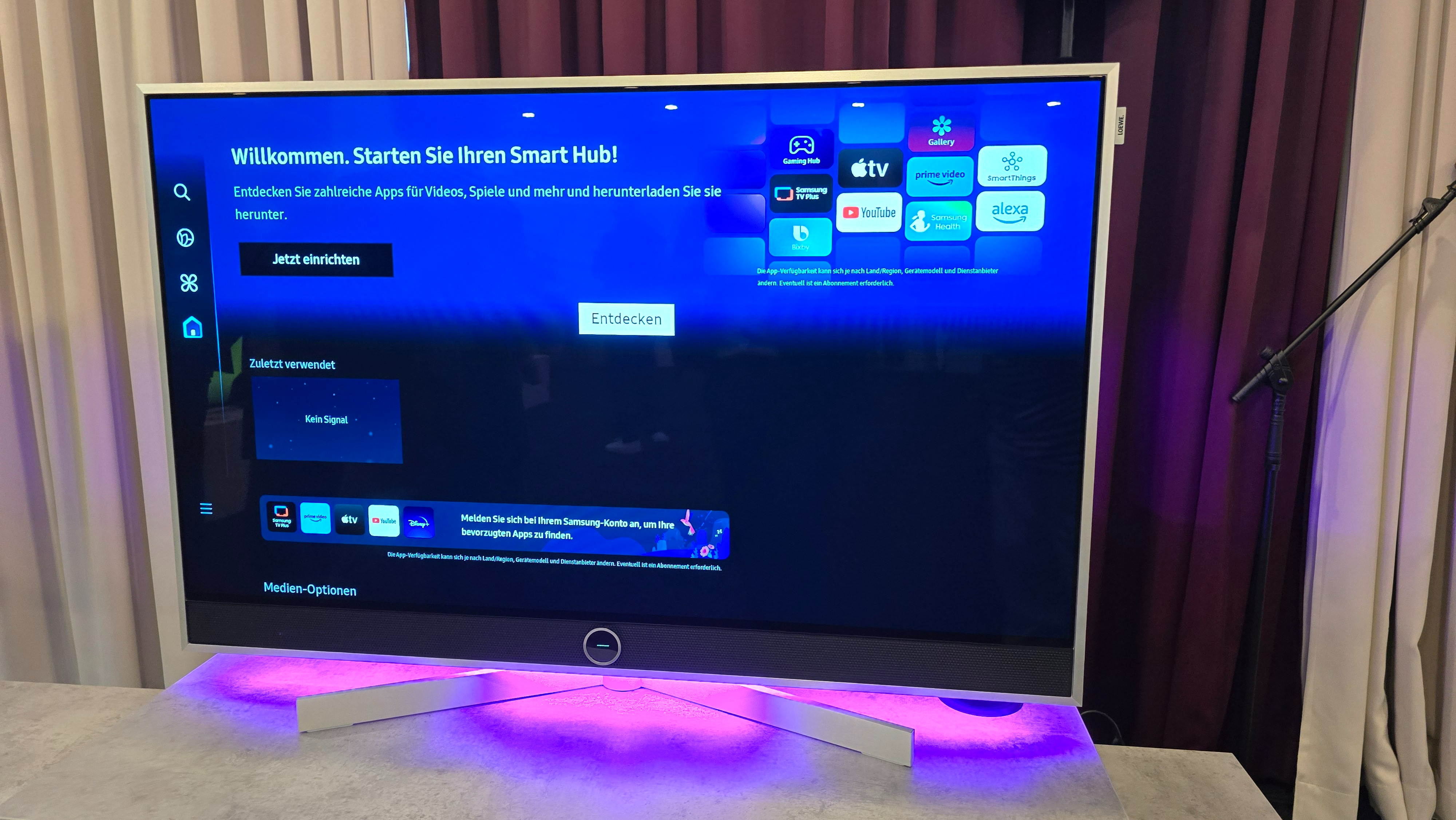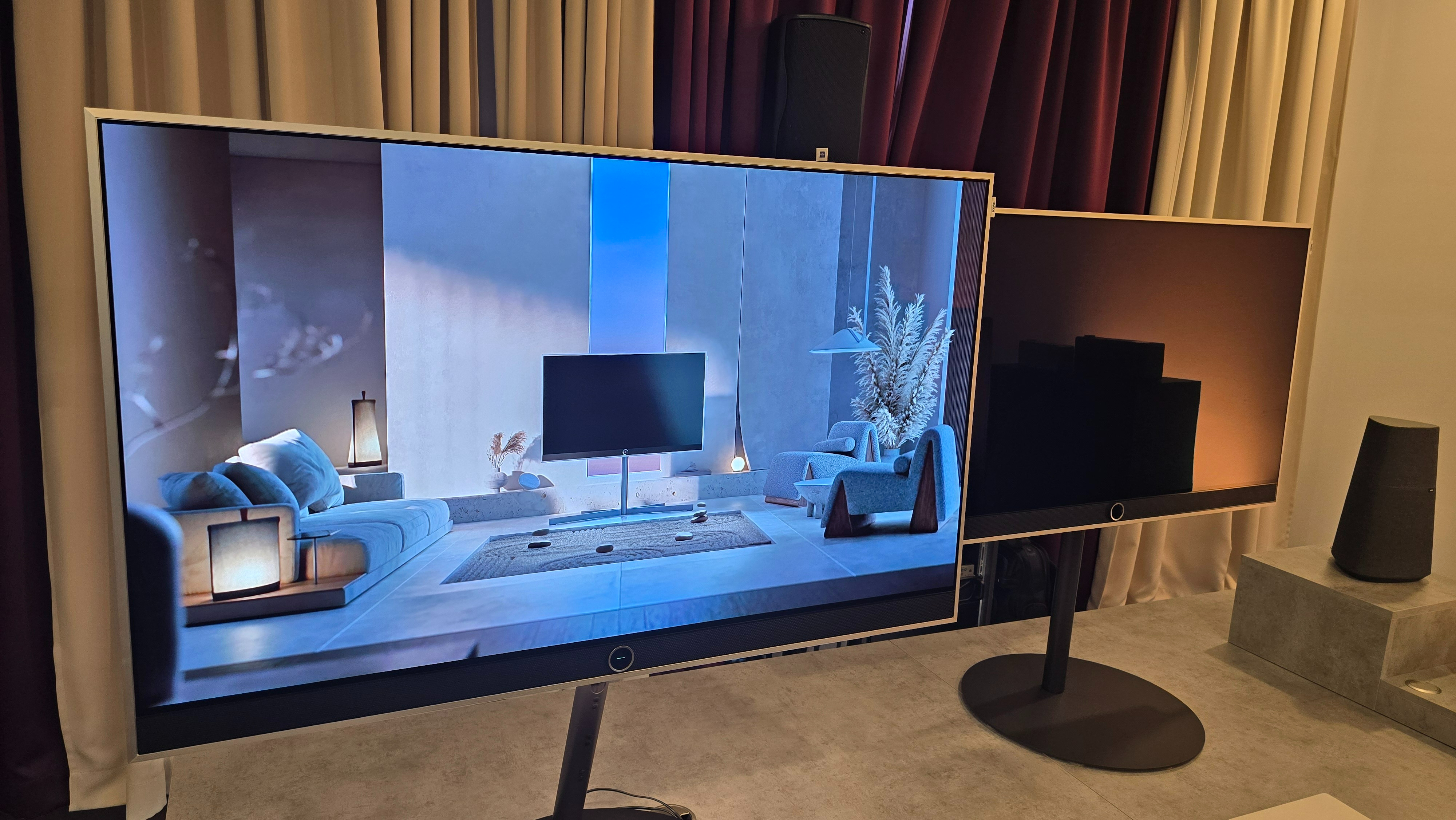
Loewe's track record of super premium, designed-focused TVs is predominantly aimed at the high-end consumer, which means we often don't find ourselves taking extended looks at its TVs. The company seems to be changing tact with its new lineup, which has a more diverse range, including an "affordable" entry-level OLED, as well as a few premium interim models that are reminiscent of the existing Bild I and Bild V models.
However, we're here to look at the brand's latest flagship model, and it's easily one of the most unusual TVs I've ever seen. The Stellar, Loewe's latest super-premium model, is an all-new effort built from the ground up with Loewe's trademark design flair and its new MLA OLED panels that it manufactures in-house at its factory in Kronach, Germany.
I was introduced to an early prototype of this set during a visit to Loewe's production plant earlier this year, with a follow-up visit to Berlin, where the company had multiple working units in a variety of sizes. So what do I think of this new concrete-clad flagship TV? We'll have to wait until the Stellar graces our dedicated TV testing room to answer that question fully, but for now here are my initial impressions.
Price and design

While these two factors don't usually play a predominant role in many of the TV reviews we conduct, Loewe is a design-focused brand at heart that attaches premium price tags to its TVs, so they're important points to cover. It's worth noting here that Loewe only sells its TVs in the UK and European markets, so you won't find US or Australian pricing here.
Available in sizes ranging from 42- to 97-inches, the suggested pricing for the Loewe Stellar is as follows:
Loewe currently plans on releasing the 42- and 55-inch variants initially, with the 48-, 65-, 77-, 83- and 97-inch models going on sale later this year. Pricing is yet to be revealed for the 97-inch model, but it's safe to say it will not be cheap.
Onto the design of the Stellar, and this is where Loewe's expertise shines. If I'm being truthful, I found the design polarising at first, but seeing the refined finished version won me over to a greater extent. It won't be to everyone's taste but it certainly adheres to Loewe's established premium design language.
The build of this TV is predominantly high-grade brushed aluminium, with a bevelled metallic border that frames the entirety of the TV. The "X" shaped metallic tabletop stand is also made of brushed aluminium material, and it can rotate which is a huge bonus for functionality.
Below the screen is a black mesh which covers the front-facing speaker system with a centrally mounted "Loewe Eye". This trademark feature is used as an indicator light to display when the TV is in standby mode or switched on predominantly and it features a pleasing animation that syncs up with when the TV is switched on or off.
This is joined by a light bar that lines the bottom edge of this TV which also includes the open/close animation when the TV is switched on or off. Not to be confused with Philips' Ambilight system, this is a static bar that can be set to a single colour (default is a warm white) that is instead used as an ambient accent light.
I saw the light cycle between practically every colour imaginable, and it can also be switched off if desired – I was glad to see this as I wasn't a huge fan of this in practice, as it's by no means as functional as Ambilight, so it feels like it could be unnecessary light pollution. Loewe did point out a good feature though, in that the light stays on for a brief period after switching your TV off which means you can exit a dark room with ample visibility.
Finally, we have the most polarising design feature of the Stellar TV. This TV has a real concrete back, meaning a thin layer of stone adorns the rear of this unit. Loewe has confirmed that the manufacturing process means that every TV will be individual, as the concrete pouring process cannot be replicated perfectly each and every time. It's undoubtedly a unique look, but considering most people have their TVs with the back facing a wall, I'm not entirely sure I see the benefit of this design choice.
Loewe does sell a variety of compatible floor stands and even a pole-style floor-to-ceiling stand, so this TV can be placed with the rear panel visible if your room allows it, but nonetheless this design choice won't be to everyone's taste.
Features

Concrete isn't the only big news, as Loewe is using another unique manufacturing process with the Stellar. It's going to become the only TV manufacturer outside of Asia to assemble its own OLED panels, and they're not just any old panels. These are META OLED displays with Micro Lens Array technology, the same brightness-boosting tech we've seen in the LG G3, Philips OLED908 and Panasonic MZ2000 last year and the G4, OLED909 and Z95A from those respective manufacturers which are set to be released later this year.
Loewe's plan is to purchase the open-cell panels from an unnamed vendor (we have a good idea who this could be) and assemble them in-house. This allows them to customise the performance of the display and choose how to mount it into the frame of the TV; hence the concrete rear panel. It should be noted here that not all sizes of the Loewe Stellar will receive the MLA screen technology, as the panels are still mass-produced at specific sizes between 55 and 83 inches. That means the smallest 42- and 48-inch models will feature a regular WOLED panel, as does the largest 97-inch model.
It's a 4K resolution panel (as to be expected) with support for Dolby Vision HDR, and Loewe is finally getting with the times and adding support for 120Hz refresh rates. Better yet all four HDMI sockets on this TV are the HDMI 2.1 standard with support for full 48GB bandwidth signals, meaning 4K/120Hz gaming with VRR and ALLM are all possible. Loewe attributes this to the new Novatek chipset inside, which we've seen on a small handful of other TVs, including Philips' cheapest 2024 OLED model.
This is a pretty major deal, as even the biggest manufacturers such as Sony, Panasonic, Philips, Hisense and TCL can only seem to manage with two HDMI 2.1 sockets, so seeing a niche brand solve this issue before they did should put this into perspective. However, it should be noted that the Novatek processor doesn't appear to be as powerful as the Mediatek Pentonic 1000 chip that's used in the TVs made by the aforementioned brands, which could have a knock-on effect on picture quality.
Picture

Here is where we have to caveat that the conditions we saw the Stellar in were by no means suitable for testing, so any final judgements will be made after this TV has been tested in our controlled AV room. I saw this TV in a large hotel conference room, with a metric ton of ambient light and lots of other people walking around, so it was by all accounts not the best way to view the TV.
That being said, I did get to see the Stellar in action in both the 42-inch and 55-inch sizes with a brief demo reel on repeat which allowed me to gather some initial thoughts. In the MLA-touting 55-inch size, the Stellar was noticeably bright and crisp. A shot of the TV sitting in a modern upscale living room with light pouring in through the windows looked bold and vibrant, and contrast seemed impressive when said scene transitioned into a nighttime version.
The smaller model does sacrifice a touch of brightness thanks to the fact it lacks the Micro Lens Array layer, however, it remains crisp and vibrant with deep blacks during the same showreel as seen on the 55-inch model.
Sound

As is the case with practically every TV event, listening to these TVs with a critical ear is nigh on impossible. I'll keep it short and sweet, the Stellar was muted during the event, and the amount of ambient noise in the room would have impacted any sound performance testing anyway.
Loewe claims that the Stellar features a sound system with up to 200W of power (presumably this is the figure given for the largest model) and it says that it produces a "mighty sound that’s rich and precise". This TV is also set to include support for Dolby Atmos immersive audio too.
Early verdict

It's too early to make a call on the Stellar, and truthfully speaking that case might remain. Judging TVs such as this one is incredibly tricky, as they only really appeal to a certain demographic. Convincing someone to spend over double the price of a 42-inch LG C4 for a TV that likely uses the same panel with Loewe's added design and feature flairs is no easy task.
However, viewing this TV as a statement piece instead makes more sense. This luxury product won't suit everybody's style or budget, but in isolation, it's a unique and intriguing TV that will certainly turn heads.
MORE:
Read our LG G4 hands on review
And our full Panasonic MZ2000 review
As well as our picks for the best OLED TVs







